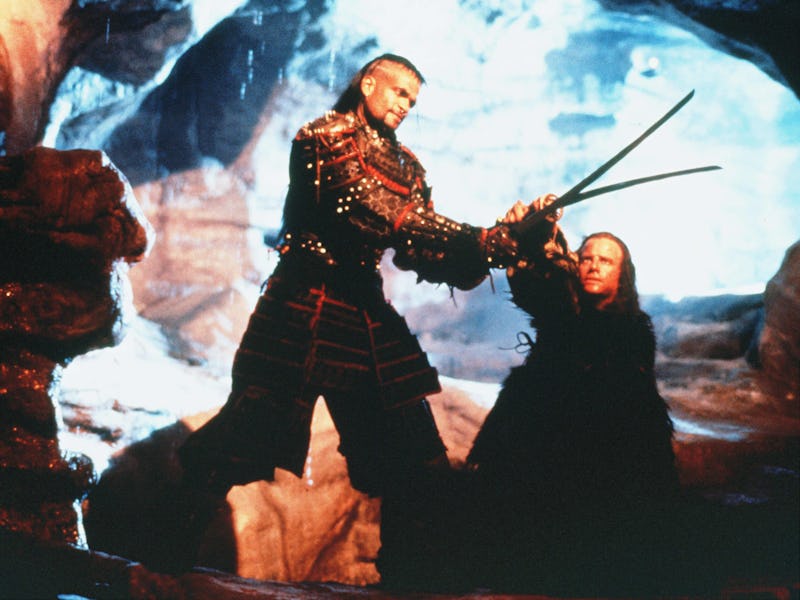The Follow-Up To The Worst Highlander Sequel Was Somehow… Worse
Must Highlander sequels outright suck? Or can they be merely bad?

For many, Highlander 2 is the worst entry in the complex, immortal-focused fantasy saga. Its plot is incoherent and barely relates to the original, the action is hit-and-miss, and even Sean Connery is can’t save it. But is it the “worst”? That all depends on your point of view. Sometimes seeing the actual worst thing, full of missteps and incongruent ideas can be amazing, particularly if that piece of failed art is really nuts. The other kind of “worst thing” though, is actually worse, because that’s when the worst thing is mediocre and safe-ish, to the point of being forgettable and dull. And this is why if you pit Highlander 2 (1991) against Highlander 3 (1995), the latter is actually worse, even though, technically, it’s better.
Here’s why, thirty years later, Highlander 3: The Final Dimension is such a bizarre sequel, but why longtime fans like me still want to love it so much. Spoilers ahead.
Released on January 27, 1995, barely three years after the 1992 TV debut of Highlander: The Series presented a totally alternate continuity from both the original film and Highlander 2, this third film starring Christopher Lambert as the titular sword-swinging immortal attempted to split the difference. While Lambert’s character, Connor Macleod, appeared in the opening episode of the TV show, symbolically passing the sword to Duncan Macleod (Adrian Paul), the third film didn’t acknowledge the existence of this newly-created timeline at all. Instead, Highlander 3: The Final Dimension (released as Highlander 3: The Sorcerer in some markets) presented itself as a straight-up sequel to the original film, in which Connor was the last immortal on Earth, after defeating the Kurgan (Clancy Brown) in New York City in 1985.
But, turns out not all the immortals were gone, because one immortal guy, a murdering tyrant named Kane (Mario Van Peebles) was frozen in a cave in 16th-century Japan. Apparently, the all-powerful immortal magic failed to notice frozen immortals when it granted Connor “the prize,” a kind of quasi-telepathic ability to communicate with all of humanity.
But, for Highlander 3, the less said about the philosophical implications of the first film, the better. Like so much of the Highlander mythos, events are often divorced from their meaning, in order to make sure heads are rolling and swords are swinging. Once Kane is unfrozen, thanks to an archaeological dig in Japan, Connor gets that Jedi vibe that there’s a presence out there, that he hasn’t felt in a long time. And so, in order to bring balance to the Freddie Mercury kind of magic that dominates Highlander, a showdown between Connor and Kane is inevitable. (Sidenote: Queen did not return to do the music for Highlander 2, and briefly Guns N' Roses was supposed to do the soundtrack. But, because Axl Rose apparently had beef with Mario Van Peebles, it never happened)
Christopher Lambert as Connor Macleod and Deborah Unger as Dr. Alex Johnson.
Although Highlander 3 introduced a new villain and a new reason for Connor to rejoin the fight, the film bizarrely becomes a remake of the original. Once again, Connor is haunted by his past, but in the present, falls in love with the one person who could understand him; someone who studies the past for a living. In the first film, this was historian-turned-forensic cop Brenda Wyatt (Roxanne Hart), and in Highlander 3 it’s Dr. Alex Johnson (Deborah Unger), an archeologist. Unger oddly plays a dual role in the film, both as Johnson in the present, and also, as a lady in the 1788 named Sarah Barrington, who happens to look exactly like her. This means that over the centuries, Connor tends to fall in love with people who look the same, which is supposed to make us feel...nice?
We’re also supposed to buy this because we’re told Connor’s true love Brenda perished in a car accident shortly after the events of the first film. This detail is interesting because it directly contradicts Brenda’s future-tense fate in Highlander 2, which, technically, was set in a bleak future, in the year 2024 (no quarrel from the vantage of 2025). In a sense, then, Highlander 3 was a quiet reboot, it was asserting that the future we saw in Highlander 2, along with all that baggage about the immortals being from another planet, never really happened. But instead of moving forward with a new story, Kane does nearly everything that the Kurgan did in the original Highlander, and the resolution of the story is more or less the same. Connor’s voiceover at the end of the film hilariously states: “It’s finally over.”
Mario Van Peebles as Kane in Highlander 3.
But, of course, it wasn’t. The TV series starring Connor’s clansman, Duncan, was going strong, and would run until 1998. Following that, Lambert would appear as Connor one more time in the film Highlander: Endgame (2000), which would seemingly reassert the TV continuity and suggest that only a few things from the original movie had happened. This means that five years after Highlander 3 hit theaters, Highlander 4 would contradict its canonicity, which is exactly what Highlander 3 did to Highlander 2, and what Highlander 2 did to itself with a home video release that changed its backstory.
Oddly enough, if you’ve followed all of that, this still means that Highlander 3 is the best of the direct sequels to the original film. But that’s only a technicality. It's an inoffensive Highlander film, that is only a partial train wreck. And let’s be honest if you’re going to watch a screwy Highlander movie, it’s probably better if things make even less sense.